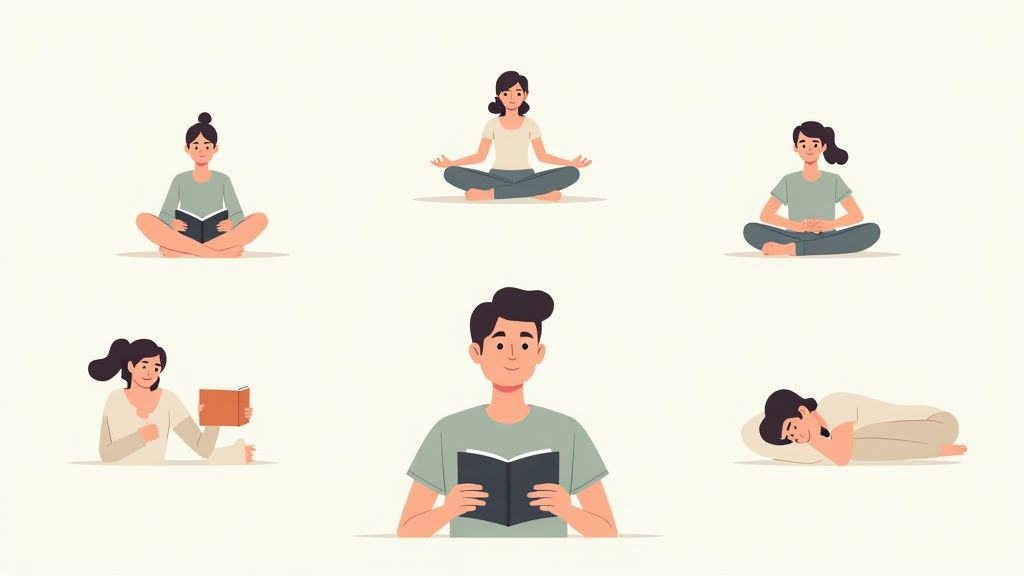Advertisement
Lifestyle
5 Techniques for Measuring Stress Levels

Monitoring Stress: 5 Methods for Stress Measurement
Introduction: Understanding Stress
Everyone experiences stress. It’s a natural human response to demanding situations and challenges, making us feel anxious or overwhelmed. However, chronic stress negatively affects both physical and mental health which makes it essential to monitor and manage our stress levels.
Stress reflects the body’s response to what we perceive as an unmanageable situation. The process begins when we encounter what we perceive as being a psychological threat. Our bodies respond by activating the nervous system and specific hormones. The body gets ready for action, leading to increased heart rate, blood pressure, and metabolism – known symptoms of stress.
Stress monitoring, therefore, can be seen as a preventive measure against health problems associated with chronic stress like insomnia, anxiety disorders, depression, heart disease, and type 2 diabetes. It is high time that you started taking your stress seriously and monitored your stress level regularly.
For instance, Judy has been feeling overwhelmed at work recently. She feels tired all the time, and she often has headaches. After talking to her doctor, she decides to start monitoring her stress levels using different methods.
- Judy starts maintaining a stress diary where she records her feelings, functions, and reactions daily.
- She also takes note of her eating and sleeping patterns to understand if there’s any abnormality.
- Judy tries out relaxing techniques and tracks changes in her stress levels before and while implementing these methods.
- She consults a professional who uses biofeedback technology to monitor her physiological responses.
- Finally, Judy opts for an HRV test suggested by her doctor to get scientific data about her body’s stress reactions.
The Importance of Regular Monitoring
The first step towards addressing stress-related issues is consistent stress monitoring. Regular observations will enable you to understand the trends and triggers leading to increased tension. It will also help you grasp how your body responds to specific circumstances, assisting in personalizing stress management strategies for yourself.
Stress monitoring is a form of self-awareness. It educates you about your emotional wellbeing and the steps required for maintenance or improvement. It focuses on determining the physiological signals that your body sends during stressful episodes to develop techniques to proactively handle such situations.
Also, regular stress monitoring promotes healthful routines. It encourages mindfulness techniques like meditation and yoga while discouraging unhealthy behaviours such as overeating, smoking, and consuming excessive alcohol, all of which only serve to magnify stress levels in the long run.
Let’s consider John who was dealing with chronic stress without realizing it until he started monitoring his stress regularly.
- John began by keeping a record of his daily activities and emotions related to them.
- He noted a spike in stress levels during team meetings, tight deadlines, and heavy traffic situations.
- John saw improvement from incorporating short breaks throughout the workday, practicing deep breathing exercises, and switching to public transport.
- He also improved his diet and included regular physical activity, noticing significant reductions in his stress levels.
- This entire process helped John understand his stress triggers, allowed him to take prompt action, and eventually reduced his stress significantly.
1. Maintain A Stress Diary
The easiest way to monitor stress is by keeping a diary. You can note down your feelings and track any notable changes in behaviors or trends. Recognizing these behaviors will help identify potential triggers and deal with them effectively.
A stress diary also helps identify the stress-induced thoughts which bring unpleasant physical and mental symptoms. It tends to improve the ability to manage our reactions to those stimuli next time they occur, hence alleviating overall stress anonymously.
Lastly, jotting down your feelings can have therapeutic effects. It provides an outlet for emotions and allows you to explore personal insights, leading to stress reduction.
Take Sarah, for example, who is a university student facing stress due to her studies and part-time job.
- Sarah starts maintaining a stress diary, recording daily activities, and related feelings.
- She notices that her stress levels increase around exam times and when shifts at her job overlap with her study time.
- Sarah chooses to focus on time management and relaxation techniques during these periods.
- She gradually learns to manage her schedules better, simultaneously reducing her overall stress levels.
- The strategy eventually makes her more productive and less anxious about her academic performance and work responsibilities.
2. Investigating Sleeping and Eating Patterns
Monitoring sleeping and eating patterns can provide profound insights into your stress levels. Sleep deprivation and irregular eating habits are often indicative of high stress.
Lack of adequate sleep increases stress hormone levels (cortisol), thus making one feel more stressed. Similarly, excessive eating or loss of appetite could be signs of emotional distress, which should be paid attention to.
By monitoring the quality and quantity of sleep and food consumed, you can track your overall wellbeing. It also opens up avenues to improve lifestyle choices consequently aiding in stress reduction.
Meet Jane, a single mother juggling between managing her full-time job and taking care of her two-year-old daughter.
- Jane has been experiencing inadequate sleep and poor eating routines; she decides to monitor these patterns closely.
- Upon noticing frequent late-night snacking and restless sleep, she consults a dietitian and a sleep therapist.
- They give her suggestions like including physical exercise in her daily routine, arranging meals at regular intervals, and establishing a strict bedtime ritual.
- Over time, Jane notices improvements in her sleeping and eating habits, which significantly reduces her stress levels.
- Jane now feels more energetic at work and experiences less anxiety while handling her parental duties.
3. Engaging in Stress-Reducing Activities and Gauging Their Effectiveness
Actively engaging in relaxing activities could assist in controlling stress levels. These include meditation, yoga, massages, or simply listening to calming music. It’s vital to keep track of these experiences to understand their effectiveness better.
Monitoring how often you indulge in these activities and the extent of your relaxation post these sessions would yield valuable information about your stress response. Having insights into what works best for your peace can guide you in creating customized strategies that significantly reduce stress.
Moreover, actively focusing on self-care reassures your subconscious mind that you’re taking charge and leads to feelings of empowerment, hence lowering overall stress.
Consider Mark who has been battling high-stress levels due to increasing responsibilities at work.
- Mark decides to try out different stress-reducing activities like deep-breathing exercises, tai chi, and outdoor running.
- He keeps a log to note down his feelings pre and post these activities to gauge their effect.
- Mark finds out that tai chi and deep-breathing exercises help him relax most effectively.
- So, he incorporates these activities more regularly in his routine and observes a significant decrease in his overall stress levels.
- Mark begins to feel more relaxed at work and handles his responsibilities more artfully.
4. Professional Monitoring: Biofeedback
Consulting professionals for neuropsychological monitoring offers scientific data regarding the stress response. One such technique is biofeedback. This treatment teaches you to control different physiological functions that correspond with stress by gaining awareness about them.
During biofeedback, a therapist attaches sensors or electrodes to your body and measures key physiological functions like muscle tension, heart rate, blood pressure, breathing, and skin temperature. The data collected provides valuable information about the body’s response to stress.
Regular sessions allow individuals to understand their stress reactions and learn how to control them more effectively using relaxation techniques and mental exercises.
Take Micheal, for instance, who sought professional help for managing his stress levels.
- Micheal opted for biofeedback therapy wherein he learned to control his physiological responses to stress.
- He took note of the triggers that caused his heart rate and blood pressure to spike, associating them with stressful situations.
- Using different relaxation techniques and mental exercises recommended by the therapist, Micheal successfully reduced his reaction to these triggers.
- Over time, he experienced less stress in previously challenging situations.
- Through this intervention, Micheal cultivated healthier responses to stress allowing for substantial psychological relief.
5. Heart Rate Variability (HRV) Testing
Watching over heart rate variability (HRV) is another scientific method of understanding management and adaptability to stress. Your HRV is the variation in time between each heartbeat, controlled by an autonomous nervous system. It changes based on the level of activity, respiration, emotions, stress, and overall health.
A lower HRV can suggest higher stress levels as it indicates less resilience and flexibility of the cardiovascular system to adapt to changing circumstances. Hence, monitoring HRV can be quite helpful to evaluate personal stress levels.
Moreover, many contemporary fitness watches and trackers offer HRV tracking features, combatting the need for professional assistance in some cases. Easy-to-read charts and graphs provide insight into your stress patterns throughout the day.
Consider Emily, an entrepreneur, who turned to HRV testing to manage her stress.
- Emily started tracking her HRV using a fitness tracker which she wore throughout the day.
- The device provided her an hourly and daily overview of her reactions to various stress triggers during work.
- She identified her peak stress level times and consciously took time out for short relaxation sessions during these hours.
- Upon tracking her HRV regularly, Emily experienced a noticeable reduction in her stress levels.
- This approach helped Emily stay relaxed, enhancing her productivity and creativity at work.
Summary Table
| Methods | Purpose | Benefits |
|---|---|---|
| Maintain A Stress Diary | Tracks changes in feelings and behaviors | Identifies stress triggers |
| Investigating Sleeping and Eating Patterns | Examines quality and quantity of sleep and food consumption | Detects emotional distress due to stress |
| Engaging in Stress-Reducing Activities | Gauges effectiveness of relaxing activities | Creates personalized activities that significantly reduce stress |
| Professional Monitoring: Biofeedback | Monitors physiological functions corresponding with stress | Maps body’s unique stress responses |
| Heart Rate Variability (HRV) Testing | Checks individual’s ability to adapt to stress | Shows resilience and flexibility of the cardiovascular system |
The above-shared methods help monitor stress personally and scientifically. Remember that everyone reacts differently to stress, so there’s no one-size-fits-all solution for managing it. The key is to find methods that work best for you and incorporate them in your daily life. With a conscious effort, you can get better at managing stress, resulting in a healthier and more fulfilling life.












